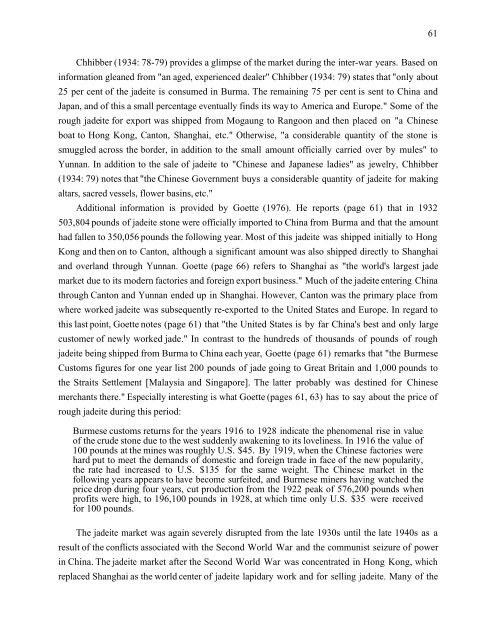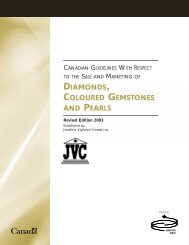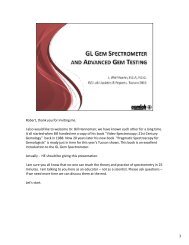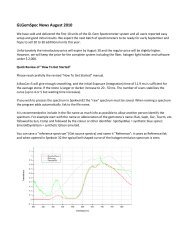JADEITE - Canadian Institute of Gemmology
JADEITE - Canadian Institute of Gemmology
JADEITE - Canadian Institute of Gemmology
You also want an ePaper? Increase the reach of your titles
YUMPU automatically turns print PDFs into web optimized ePapers that Google loves.
Chhibber (1934: 78-79) provides a glimpse <strong>of</strong> the market during the inter-war years. Based on<br />
information gleaned from "an aged, experienced dealer" Chhibber (1934: 79) states that "only about<br />
25 per cent <strong>of</strong> the jadeite is consumed in Burma. The remaining 75 per cent is sent to China and<br />
Japan, and <strong>of</strong> this a small percentage eventually finds its way to America and Europe." Some <strong>of</strong> the<br />
rough jadeite for export was shipped from Mogaung to Rangoon and then placed on "a Chinese<br />
boat to Hong Kong, Canton, Shanghai, etc." Otherwise, "a considerable quantity <strong>of</strong> the stone is<br />
smuggled across the border, in addition to the small amount <strong>of</strong>ficially carried over by mules" to<br />
Yunnan. In addition to the sale <strong>of</strong> jadeite to "Chinese and Japanese ladies" as jewelry, Chhibber<br />
(1934: 79) notes that "the Chinese Government buys a considerable quantity <strong>of</strong> jadeite for making<br />
altars, sacred vessels, flower basins, etc."<br />
Additional information is provided by Goette (1976). He reports (page 61) that in 1932<br />
503,804 pounds <strong>of</strong> jadeite stone were <strong>of</strong>ficially imported to China from Burma and that the amount<br />
had fallen to 350,056 pounds the following year. Most <strong>of</strong> this jadeite was shipped initially to Hong<br />
Kong and then on to Canton, although a significant amount was also shipped directly to Shanghai<br />
and overland through Yunnan. Goette (page 66) refers to Shanghai as "the world's largest jade<br />
market due to its modern factories and foreign export business." Much <strong>of</strong> the jadeite entering China<br />
through Canton and Yunnan ended up in Shanghai. However, Canton was the primary place from<br />
where worked jadeite was subsequently re-exported to the United States and Europe. In regard to<br />
this last point, Goette notes (page 61) that "the United States is by far China's best and only large<br />
customer <strong>of</strong> newly worked jade." In contrast to the hundreds <strong>of</strong> thousands <strong>of</strong> pounds <strong>of</strong> rough<br />
jadeite being shipped from Burma to China each year, Goette (page 61) remarks that "the Burmese<br />
Customs figures for one year list 200 pounds <strong>of</strong> jade going to Great Britain and 1,000 pounds to<br />
the Straits Settlement [Malaysia and Singapore]. The latter probably was destined for Chinese<br />
merchants there." Especially interesting is what Goette (pages 61, 63) has to say about the price <strong>of</strong><br />
rough jadeite during this period:<br />
Burmese customs returns for the years 1916 to 1928 indicate the phenomenal rise in value<br />
<strong>of</strong> the crude stone due to the west suddenly awakening to its loveliness. In 1916 the value <strong>of</strong><br />
100 pounds at the mines was roughly U.S. $45. By 1919, when the Chinese factories were<br />
hard put to meet the demands <strong>of</strong> domestic and foreign trade in face <strong>of</strong> the new popularity,<br />
the rate had increased to U.S. $135 for the same weight. The Chinese market in the<br />
following years appears to have become surfeited, and Burmese miners having watched the<br />
price drop during four years, cut production from the 1922 peak <strong>of</strong> 576,200 pounds when<br />
pr<strong>of</strong>its were high, to 196,100 pounds in 1928, at which time only U.S. $35 were received<br />
for 100 pounds.<br />
The jadeite market was again severely disrupted from the late 1930s until the late 1940s as a<br />
result <strong>of</strong> the conflicts associated with the Second World War and the communist seizure <strong>of</strong> power<br />
in China. The jadeite market after the Second World War was concentrated in Hong Kong, which<br />
replaced Shanghai as the world center <strong>of</strong> jadeite lapidary work and for selling jadeite. Many <strong>of</strong> the<br />
61









